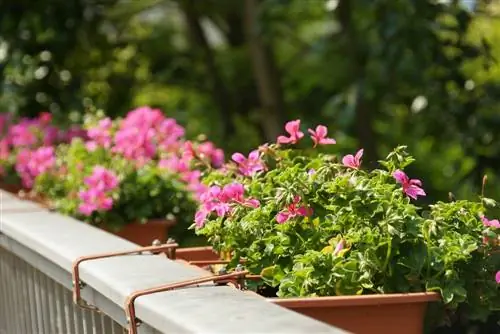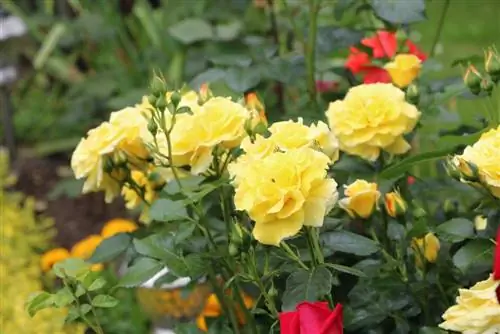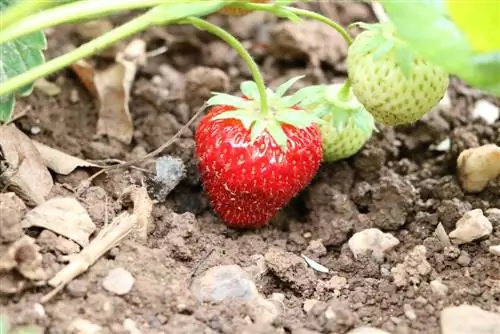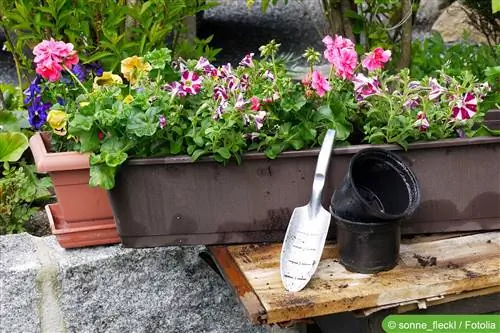- Author admin [email protected].
- Public 2023-12-17 03:39.
- Last modified 2025-06-01 06:48.
The best time to plant flowers depends, among other things, on the type of flower, the flowering time and its frost resistance. There is no generally valid best time to plant. Both flower boxes and containers can be planted almost all year round, with plants suitable for the corresponding season. While the first summer or autumn blooming flowers can be brought forward from February/March, others can even be planted into winter if the temperatures are mild. Of course, the prerequisite is always frost-free ground.
Planting time spring
The best planting time for autumn and summer bloomers is from March to May. From March/April, summer-flowering onion plants can be planted in pots or boxes, such as: B. Lilies, gladioli, begonias, cyclamen, Montbretia or the flower reed. Other summer bloomers such as slipper flowers, snapdragons, fairy mirrors, busy lilies, ice begonias, verbena or purslane can be grown indoors from March onwards.
At the beginning of the frost-free period, the frost-sensitive geraniums, begonias, fuchsias, dahlias or the busy lilies can be planted directly in flower boxes. It is important not to plant too early or before the ice saints, because tubers like dahlias are also very sensitive to frost.
Winter asters and hardy chrysanthemums can also be planted in spring, although these flowers can also be planted in autumn. However, spring planting is more advantageous here so that the plants can form sufficient roots and gather strength for flowering by autumn.
Tip:
Onion flowers that have overwintered in the flower box in the cellar should also not go outside before the Ice Saints, because only then is the danger of night frosts averted.
Planting time summer
- Even in summer, flowers can still be planted in pots or flower boxes.
- However, the selection isn't quite as big anymore.
- - In summer, varieties that are in season in autumn are planted.
- Accordingly, August, for example, is the best time to plant late-blooming flowers.
- These include, for example, autumn crocuses, the autumn crocus or the starbergie.
- Approximately 6 weeks after planting, these autumn bloomers are already showing their full blooms.
Tip:
Flowers planted in summer should initially be protected from direct sunlight and watered sufficiently, preferably in the early evening hours.
Planting time autumn
In autumn, the first summer flowers are transported to the cellar to overwinter. Between September and October, and depending on the weather sometimes even until December, is also the best time to plant spring bloomers. The most beautiful early bloomers that can now be planted in boxes and pots mainly include bulbous flowers such as tulips, hyacinths, crocuses, daffodils, snowdrops, March cups, imperial crowns, ray anemones, winter aconites, squill and daffodils.
Smaller flowering perennials such as Adonis florets, violets or liverworts are also preferably planted in autumn. They are now planted in flower boxes and overwintered in an unheated cellar until spring until they can finally move outside to the balcony or terrace after the Ice Saints, i.e. around the middle. Autumn is also the best time to plant frost-resistant pansies or horned violets, which usually survive the winter well and are in full bloom in spring. Now is also the right time to divide spring and summer flowering perennials, but also to replant or replant them.
Tip:
If there is a longer frost-free period, typical early bloomers can also be plugged or planted in winter. The popular Christmas rose is also one of the few plants that can be planted well into winter.
The most common mistakes when planting flower boxes
Substrate and plants
When planting flower boxes, you should make sure to use the highest quality potting soil possible, as this is a basic requirement for optimal growth and the willingness to flower of the various plants. You can also go wrong when choosing plants. Low-growing flowers are particularly suitable for flower boxes; perennials that grow too high would draw too much energy from the substrate and thus represent competition to low-growing species. When buying flowers, you should only give preference to varieties that have a well-developed root ball, otherwise there may be problems with growth. When you lift the plants out of the pot, the root ball should be clearly visible.
Watering problems
Most mistakes are usually made when pouring. First, good drainage is essential. Place a fleece on top of the drainage and then the earth on top of it. Water thoroughly immediately after planting. To avoid sunburns, you should not water in the blazing midday sun, but rather in the morning or early evening hours.
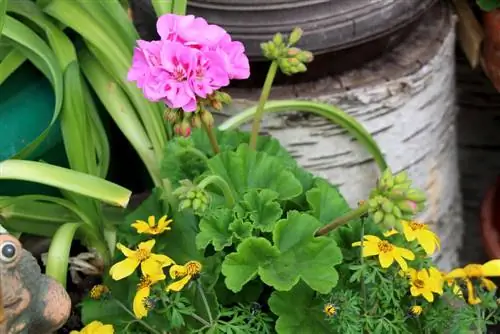
You should also not water over flowers and leaves and ideally with rainwater. Flower boxes with so-called filler necks are now also available in stores. These have the advantage that the plants always have a certain amount of water storage, which is especially useful if you are often away for long periods of time.
Errors when sowing and planting
- When sowing balcony flowers, you have to differentiate between light and dark germinators.
- It is still important to separate the seedlings as early as possible.
- Before planting, it is advisable to water the root balls of the flowers thoroughly.
- After planting the plants, don't forget to press the soil down well.
- This is to prevent cavities from forming in the earth.
Tip:
Vacities left in the soil could promote mold growth and cause long-term damage to the flowers.
The best plants for north, east, south and west balconies
North Balconies
When selecting flowers for planting in flower boxes, the orientation of the balcony plays a crucial role, because the plants only thrive in the optimal location. Little to no sun reaches north-facing balconies. Therefore, plants that feel more comfortable in the shade are suitable for this. These include, among others, lobelias, busy lilies, hydrangeas, begonias, dahlias, snowflake flowers and purple bells.
East and West balconies
East and west balconies are generally ideal for planting because the plants are sometimes sunny and sometimes shady, ideal conditions for most plants. While east-facing balconies have sun mainly in the morning, west-facing balconies are more sunny in the evening. Accordingly, flowers that are suitable for partially shaded areas can be planted here. These could be petunias, for example, but lilies, night violets, chrysanthemums, hydrangeas, fuchsias, dahlias or busy lilies would also be suitable for this.
South balconies
For south-facing balconies you should only choose flowers that can tolerate all-day sun, even full midday sun in summer. These include daisies, petunias, lantanas, geraniums, the blue fan flower, the elf spur, the blue daisy, the hussar's head, the purslane or the vanilla flower.
Conclusion
Flowering areas are usually only sparse, especially in cities. This makes it all the more important to equip your own balcony with lush flowering flower boxes and pots. The best planting times for different types of flowers cannot be given in general terms, as they depend on several factors. While frost-sensitive plants are mainly planted in spring, frost-hardy plants can sometimes be planted into winter. In addition to the robustness of the plants, the orientation of the balcony also plays an important role. For example, if you plant sun-hungry flowers on a north-facing balcony, even with the best care you won't be able to enjoy the plants because they won't be able to develop optimally here.

